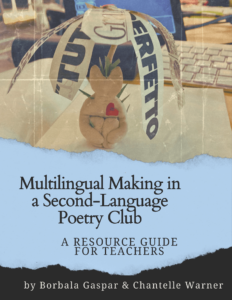 This new OER is a culmination of conversations, pedagogical practices, and ways of being together that developed as a collaboration between co-authors Borbala Gaspar and Chantelle Warner (at the University of Arizona) and the engaged group of students who took part in a year-long series of extracurricular gatherings, which served as an exploratory space for the ideas shared in this handbook. The poetry club evolved from the authors’ shared desire to create a space adjacent to the classrooms in their language programs (Italian and German respectively) where students could explore the aesthetic and affective endeavor of language learning, rooted in the human capacity for exploring alternative ways of making sense of themselves, the world, and their experiences within it.
This new OER is a culmination of conversations, pedagogical practices, and ways of being together that developed as a collaboration between co-authors Borbala Gaspar and Chantelle Warner (at the University of Arizona) and the engaged group of students who took part in a year-long series of extracurricular gatherings, which served as an exploratory space for the ideas shared in this handbook. The poetry club evolved from the authors’ shared desire to create a space adjacent to the classrooms in their language programs (Italian and German respectively) where students could explore the aesthetic and affective endeavor of language learning, rooted in the human capacity for exploring alternative ways of making sense of themselves, the world, and their experiences within it.
This handbook is intended as a resource for educators who wish to develop a similar extracurricular club or who are looking for inspiration for their classrooms. In the first chapter of the handbook, we introduce you to the background of the project and the current discussions of well-being in higher education. Part two provides an overview of the conceptual underpinnings of multilingual making and poetic play as ways of engaging with language and language learning. Core concepts and principles are outlined, emphasizing the significance of living together in and through languages, and the role of multilingual making when learning a new language. The handbook explores various forms of poetic play, such as collage, response artwork to poetry, clay work and visual representation of poems. It delves into core principles for establishing a multilingual poetry club offering guidance on creating and sustaining such a club. Sample activities illustrate each example including collage, mixed media, limericks, and remarks from the authors and creators of the artworks. Additional resources such as blackout poetry and other ideas that could potentially further engage club members in creative expression are included as well. Finally, this book concludes with reflections and additional resources for educators interested in promoting multilingualism and creativity through poetry.
After reading this handbook, you will be able to…
- Identify the key factors that students indicate as influencing their sense of belonging;
- Define and discuss key concepts and terms related to playful poetry and living literacies approach, and relate them to other discussions in the field of second language teaching and learning;
- Explore the forms and functions of multimodality and living literacies in the examples;
- Reflect on how to apply these ideas into your context.
This work is available free of charge, and published under the Creative Commons license
This license enables reusers to distribute, remix, adapt, and build upon the material in any medium or format for noncommercial purposes only, and only so long as attribution is given to the creator.

